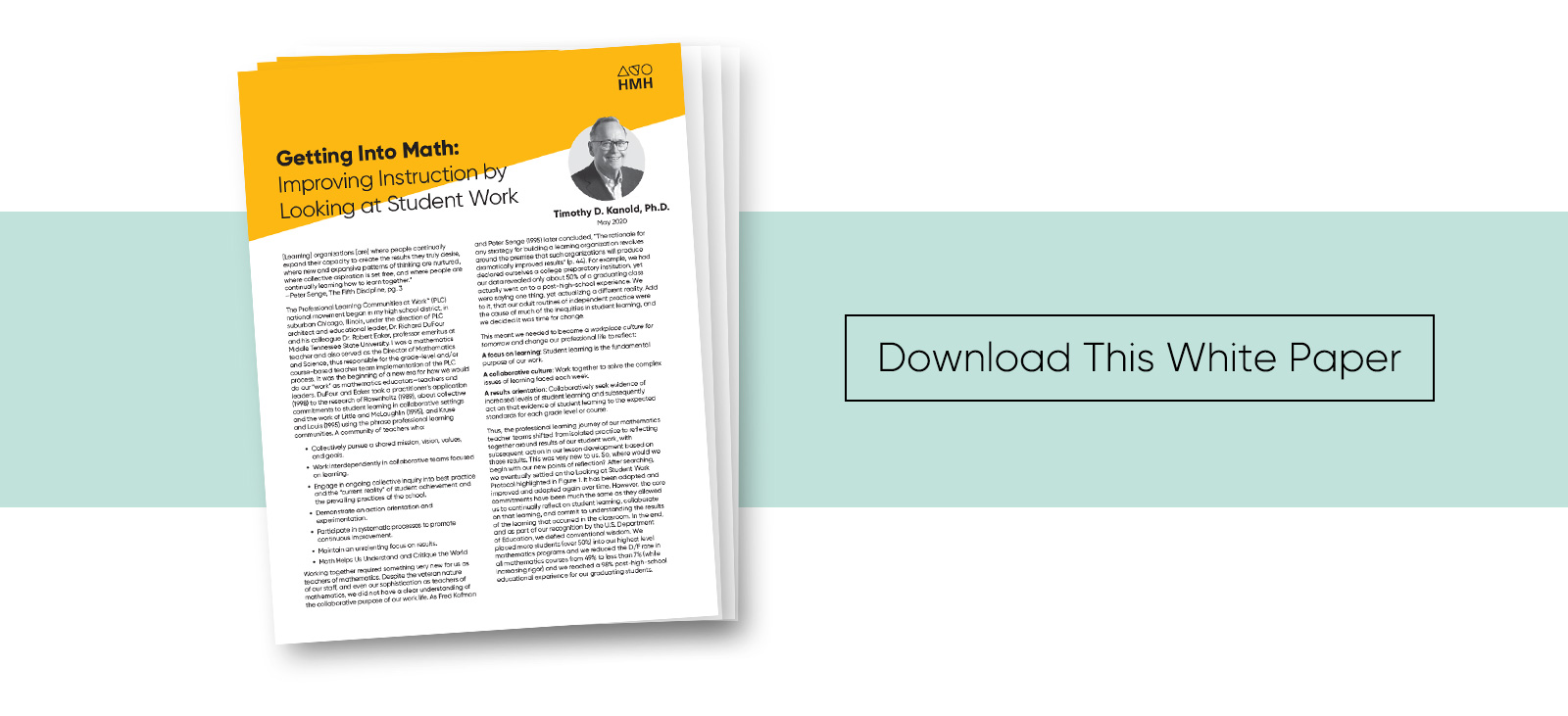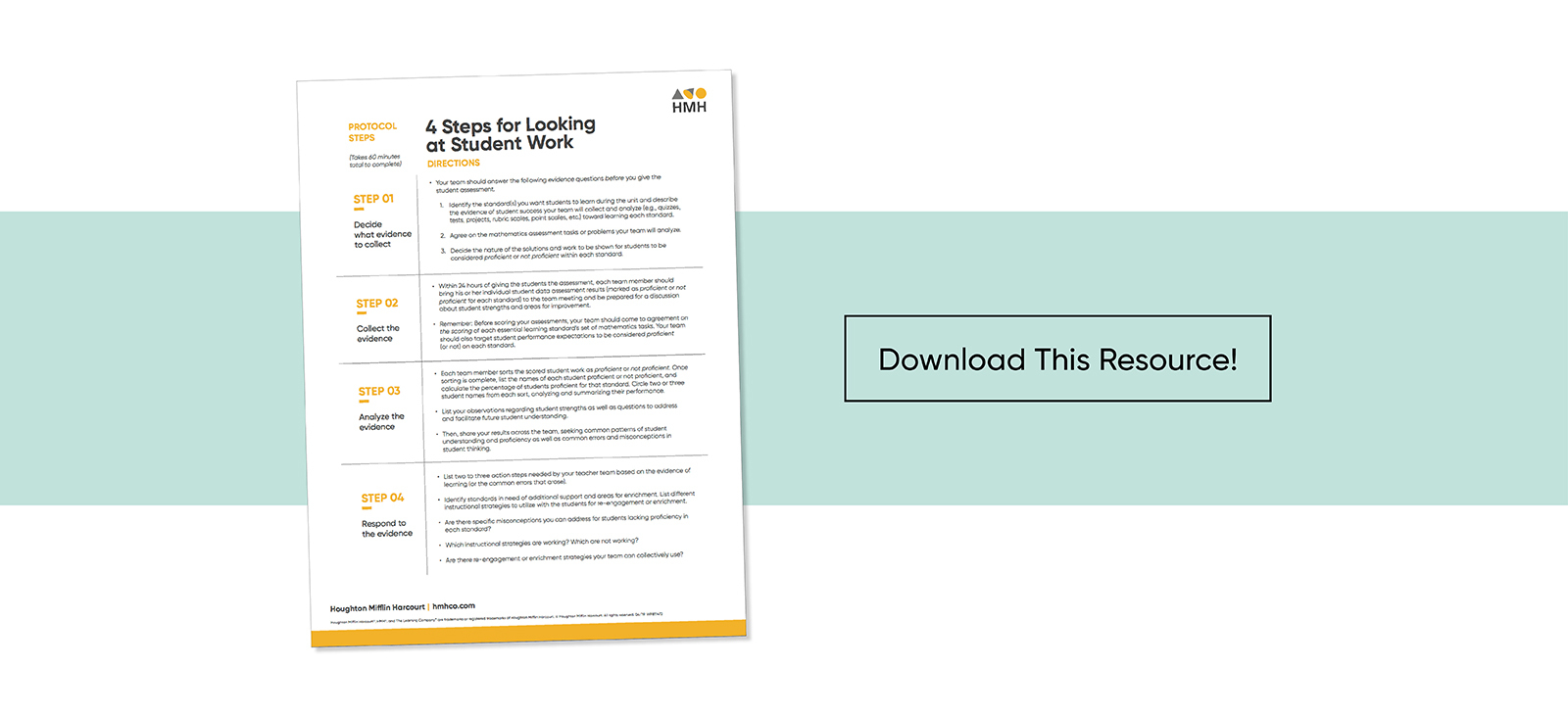
The Professional Learning Community At Work™ (PLC) national movement began in my high school district in Illinois under the direction of PLC At Work™ architect and educational leader Dr. Richard DuFour. At the time, I was a mathematics teacher and also served as the Director of Mathematics and Science. I was responsible for the grade-level and/or course-based teacher team implementation of the PLC process and the weekly team meetings in mathematics and science. The PLC At Work™ process serves the foundational improvement of your collective teacher efficacy and operates under the assumption that the key to improved learning for students is continuous job-embedded learning for you and your colleagues.
The Benefit of Collaborative Teams
One advantage of the collaborative team process was the opportunity to use results of student work to inform our practice and subsequent strategies for daily lesson design. By 1990, organizational thought leader Peter Senge (in the book The Fifth Discipline) defined learning organizations as “organizations where people continually expand their capacity to create the results they truly desire, where new and expansive patterns of thinking are nurtured, where collective aspiration is set free, and where people are continually learning how to learn together.”
It was the beginning of a new era for how we would do our “work” as mathematics educators—both teachers and leaders.
Working together required something very new for us. Despite the veteran nature of our staff and even our sophistication as teachers of mathematics, we did not have a clear understanding of the collaborative purpose of our work life. As Fred Kofman and Peter Senge later concluded, “The rationale for any strategy for building a learning organization revolves around the premise that such organizations will produce dramatically improved results.”
Become a Workplace Culture of Tomorrow
This meant we needed to become a workplace culture of tomorrow and change our professional life to:
- A focus on learning: Focus on student learning as the fundamental purpose of our work.
- A collaborative culture: Work together to solve the complex issues of learning faced each week.
- A results orientation: Collaboratively seek evidence of higher levels of student learning, and subsequently act on that evidence to determine the expected standards for each grade level or course.
Thus, the professional learning journey of our mathematics teacher teams shifted to reflecting together around results of our student work, and taking subsequent action in our lessons based on those results. This was very new to us.
So, where would we begin? We eventually settled on a Looking at Student Work protocol highlighted in the white paper and chart available for download below. It has been adapted and improved and adapted again over time. However, the core commitments have been largely the same:
- Decide the evidence of learning to be collected
- Collect the evidence
- Analyze the evidence (This is the hardest step.)
- Plan action steps as a result of the evidence

As you and your mathematics team members use the Student Work protocol, your team discussions and depth of analysis will improve each time. The four steps of the protocol are designed to spark meaningful team discussion around the evidence of student learning you seek. This “looking at student work” together process takes about an hour to complete, so you should also decide how often you will do the analysis. I suggest at least once for each unit of mathematics taught throughout the grade level or course.
Four Steps for Looking at Student Work
1. Decide the Evidence of Learning (by Standard)
A first step for deeper analysis of student learning is to create a common assessment that may have one or more mathematical tasks—connected to an essential learning standard for the mathematics unit. Your team then works together to establish clear expectations regarding proficiency performance for the mathematical tasks on the assessment instrument you create. Since you are to analyze student learning as a progression of proficient or not proficient for each standard, be sure to discuss scoring of student work and examine the evidence of learning by standard, not merely by singular mathematics problems or tasks. This deeper analysis by standard promotes rich discussions about the reasons for correct or incorrect student work.

2. Collect the Evidence
Each teacher on your team should give the common mathematics assessment on the same day. You then score the mathematics assessment and bring a broad range of student work samples to the team meeting, as there is a benefit to examining your own set of student work and sharing with your colleagues. It will cause your data dialogue to experience increased meaning and purpose.
The collecting of evidence (giving the students the assessment and scoring their individual work) needs to be completed in a timely fashion, either the same day or within 24 hours, if possible. The expectation of “looking at student work” with your colleagues is to cause an immediate impact on your mathematics lesson design and focus over the next week.
In advance of the evidence collection, be sure to create a schedule for the collecting of evidence and then meeting as a team to analyze the evidence. If needed, have a veteran team member or district mathematics coach lead the initial analysis process.
3. Analyze the Evidence
When your team is analyzing student work, you will have intentional opportunities to identify specific mathematics learning gaps and strengths. As you complete the third step of this “looking at student work” process, your primary purpose is to determine if your students in the grade level or course are, in general, proficient or not in the mathematics standard.

A natural result of your work together in this stage of the process is to determine why students were not proficient and what the mistake patterns or common errors were, and then to analyze those misconceptions by your students. Then, share with one another instructional approaches or strategies that impacted (or not) student learning. This, in turn, builds your shared knowledge and exploration of students’ mathematical thinking.
As your grade-level or course-based collaborative team weaves through their analysis of student learning, standard by standard, your team will develop a better understanding of the proficiency levels for each essential standard. Also, do not forget to celebrate with one another student success as well, and realize you are the primary reason for that success!
4. Respond to the Evidence
After you analyze the evidence of student learning, you enter the final stage of the “looking at student work” protocol and process. Your team identifies specific teacher actions (tied to a different instructional focus) that each team member can use to determine how to improve student understanding of the standard.
It is in the taking-action stage on the student evidence of proficiency (or non-proficiency) for each mathematics standard that reveals the greatest impact on student learning. This level of data dialogue informs your collective team response to student learning. In a certain sense, you are providing your students with an intervention, as you address common student errors revealed during your team analysis of student thinking on the common assessment. Your team’s priority becomes then to act quickly on various and meaningful instructional strategies and mathematical tasks that differ from the initial core instruction, with the hope of eliminating learning gaps on the mathematical standards before students are too much further along the mathematics standards that loom ahead.
Looking at student thinking will prompt even deeper discussions across the team focused on how to impact student learning. Which specific teacher actions during core instruction promoted deeper student understanding, and which actions did not? As you and your team gain more experience with protocols for analyzing student work, you will be able to modify and adjust the protocol to meet your assessment needs.
When you create opportunities for careful examination of student learning, you open the door for your team members to take risks and improve their teaching practices as a way of shared professional growth. You help to shift your team’s focus and energy from analyzing assessment evidence of student learning to an active instructional practice and daily routine response.
As you walk your students from one mathematics standard and unit to the next, they eventually become owners of their learning, based on the analysis and effort of your team. They will learn to embrace their errors and understand learning as a more formative and less static process.
The views expressed in this article are those of the author and do not necessarily represent those of HMH.
***
Dr. Timothy D. Kanold is an author of Into Math. Learn more about the HMH solution for K–8 students here.
This blog was updated in September 2020.

















